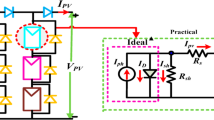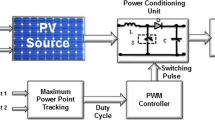Abstract
Fluctuations in the output power of photovoltaic (PV) under climate changes such as variations in temperature and radiation is an important challenge for these resources. Therefore, it is very important to keep the output power of solar systems constant without any fluctuation at their maximum power point in the event of climate change. The aim of this paper is to suggest a maximum power point tracking (MPPT) method to cancel the output power oscillation of PV systems in severEe weather conditions, especially under radiation and temperature changes. In order to find the optimal parameters of the MPPT controller, the improved shuffled frog-leaping algorithm (ISFLA) and fuzzy controller are used. In addition, to fine-tune the member functions (MFs) of FLC, the combination of the fuzzy logic controller (FLC) and the ISFLA algorithm are employed. The ISFLA is an effective solution to cope with the stochastic behavior of the PV system under changing the radiation and ambient temperature. A storage system is also used to provide more stability and reliability for the system. Simulation results show that the recommended scheme provides excellent tracking efficiency from 98.1 to 99.6%. The case study under partial shading conditions also confirms the 16% improvement in the efficiency of the proposed method and more stability compared to the conventional P&O MPPT controller.





















Similar content being viewed by others
Data availability
Enquiries about data availability should be directed to the authors.
Abbreviations
- R s :
-
Series resistance (Ω)
- R sh :
-
Shunt resistance (Ω)
- I ph :
-
Photocurrent of the cell (A)
- n :
-
P–n junction ideality factor
- I PVO :
-
Reverse saturation current (A)
- K :
-
Boltzmann constant (1.38 × 10–23 J/K)
- q :
-
Electronic charge (1.602 × 10–19C)
- T :
-
Cell temperature (Kelvin)
- I MP :
-
Maximum current
- VMP :
-
Maximum voltage
- P Max :
-
Maximum power
- V OC :
-
Open-circuit voltage
- I SC :
-
Short-circuit current
- N P :
-
Number of parallel cells
- N S :
-
Number of series cells
- U m :
-
Maximum voltage magnitude of u
- ω :
-
Angular frequency
- u d and u q :
-
Grid voltage in the dq frame
- i d and i q :
-
Inverter current in the dq frame
- L:
-
Filter inductance
- v d and v q :
-
Control voltages in the dq frame
- E :
-
Error at sample time k (input of FLC)
- CE:
-
Change in error at sample time k (input of FLC)
- D :
-
Duty cycle (output of FLC)
- Dj:
-
Center of max–min method composition at the output MF
- V PV :
-
Voltage of boost converter
- I PV :
-
Input current of boost converter
- P PV (k):
-
Power of the PV system
- \(X_{w}^{\mathrm{new}}\) :
-
Location of the weakest member in current position
- D :
-
Vector of members’ mutation
References
Abdel-Salam M, El-Mohandes MT, Goda M (2018) An improved perturb-and-observe based MPPT method for PV systems under varying irradiation levels. Sol Energy 1(171):547–561
Abu AO (2017) Adaptation of reproducing kernel algorithm for solving fuzzy Fredholm-Volterra integrodifferential equations. Neural Comput Appl 28(7):1591–1610
Abu Arqub O, Singh J, Maayah B, Alhodaly M (2021) Reproducing kernel approach for numerical solutions of fuzzy fractional initial value problems under the Mittag–Leffler kernel differential operator. Math Methods Appl Sci
Al-Dhaifallah M, Nassef AM, Rezk H, Nisar KS (2018) Optimal parameter design of fractional order control based INC-MPPT for PV system. Sol Energy 1(159):650–664
Al-Ghussain L, Ahmed H, Haneef F (2018) Optimization of hybrid PV-wind system: case study Al-Tafilah cement factory. Jordan Sustain Energy Technol Assessments 1(30):24–36
Al-Smadi M, Arqub OA, Zeidan D (2021) Fuzzy fractional differential equations under the Mittag-Leffler kernel differential operator of the ABC approach: theorems and applications. Chaos Solitons Fractals 1(146):110891
Arqub OA, Al-Smadi M (2020) Fuzzy conformable fractional differential equations: novel extended approach and new numerical solutions. Soft Comput 24(16):12501–12522
Arqub OA, Al-Smadi M, Momani S, Hayat T (2017) Application of reproducing kernel algorithm for solving second-order, two-point fuzzy boundary value problems. Soft Comput 21(23):7191–7206
Belouda M, Hajjaji M, Sliti H, Mami A (2018) Bi-objective optimization of a standalone hybrid PV–Wind–battery system generation in a remote area in Tunisia. Sustain Energy Grids Netw 1(16):315–326
Chandramouli A, Sivachidambaranathan V (2019) Extract maximum power from PV system employing MPPT with FLC controller. Power 1(4)
da Rocha MV, Sampaio LP, da Silva SA (2020) Comparative analysis of MPPT algorithms based on Bat algorithm for PV systems under partial shading condition. Sustain Energy Technol Assess 1(40):100761
Eusuff MM, Lansey KE (2003) Optimization of water distribution network design using the shuffled frog leaping algorithm. J Water Resour Plan Manag 129(3):210–225
Fulzele JB, Daigavane MB (2018) Design and optimization of hybrid PV-wind renewable energy system. Materials Today Proc 5(1):810–818
Jyothy LP, Sindhu MR (2018) An artificial neural network based MPPT algorithm for solar PV system. In 2018 4th International Conference on Electrical Energy Systems (ICEES) (pp. 375–380). IEEE
Kiswantono A, Prasetyo E, Amirullah A (2019) Comparative performance of mitigation voltage sag/swell and harmonics using DVR-BES-PV system with MPPT-Fuzzy Mamdani/MPPT-Fuzzy Sugeno. Int J Intell Eng Syst 12(2):222–235
Li X, Wen H, Hu Y, Jiang L (2019) A novel beta parameter based fuzzy-logic controller for photovoltaic MPPT application. Renew Energy 1(130):416–427
Ma T, Javed MS (2019) Integrated sizing of hybrid PV-wind-battery system for remote island considering the saturation of each renewable energy resource. Energy Convers Manage 15(182):178–190
Mansoor M, Mirza AF, Ling Q, Javed MY (2020) Novel Grass Hopper optimization based MPPT of PV systems for complex partial shading conditions. Sol Energy 1(198):499–518
Mirza AF, Mansoor M, Ling Q, Yin B, Javed MY (2020) A Salp-Swarm Optimization based MPPT technique for harvesting maximum energy from PV systems under partial shading conditions. Energy Convers Manage 1(209):112625
Mohapatra A, Nayak B, Saiprakash C (2019) Adaptive perturb and observe MPPT for PV system with experimental validation. In 2019 IEEE International Conference on Sustainable Energy Technologies and Systems (ICSETS) (pp. 257–261). IEEE
Padmanaban S, Priyadarshi N, Bhaskar MS, Holm-Nielsen JB, Ramachandaramurthy VK, Hossain E (2019) A hybrid ANFIS-ABC based MPPT controller for PV system with anti-islanding grid protection: experimental realization. IEEE Access 29(7):103377–103389
Pradhan C, Senapati MK, Malla SG, Nayak PK, Gjengedal T (2020) Coordinated power management and control of standalone PV-hybrid system with modified IWO-Based MPPT. IEEE Syst J
Priyadarshi N, Padmanaban S, Maroti PK, Sharma A (2018) An extensive practical investigation of FPSO-based MPPT for grid integrated PV system under variable operating conditions with anti-islanding protection. IEEE Syst J 13(2):1861–1871
Priyadarshi N, Ramachandaramurthy VK, Padmanaban S, Azam F (2019) An ant colony optimized MPPT for standalone hybrid PV-wind power system with single Cuk converter. Energies 12(1):167
Radhika A, Soundradevi G, Mohan KR (2020) An effective compensation of power quality issues using MPPT-based cuckoo search optimization approach. Soft Comput 24(22):16719–16725
Rahimi-Vahed A, Mirzaei AH (2007) A hybrid multi-objective shuffled frog-leaping algorithm for a mixed-model assembly line sequencing problem. Comput Ind Eng 53(4):642–666
Reddy GT, Khare N (2017) An efficient system for heart disease prediction using hybrid OFBAT with rule-based fuzzy logic model. J Circuits Syst Computers 26(04):1750061
Reddy GT, Khare N (2018) Heart disease classification system using optimised fuzzy rule based algorithm. Int J Biomed Eng Technol 27(3):183–202
Reddy GT, Reddy M, Lakshmanna K, Rajput DS, Kaluri R, Srivastava G (2020) Hybrid genetic algorithm and a fuzzy logic classifier for heart disease diagnosis. Evol Intel 13(2):185–196
Roy RB, Rokonuzzaman M, Amin N, Mishu MK, Alahakoon S, Rahman S, Mithulananthan N, Rahman KS, Shakeri M, Pasupuleti J (2021) A comparative performance analysis of ANN algorithms for MPPT energy harvesting in solar PV system. IEEE Access 13(9):102137–102152
Samy MM, Barakat S, Ramadan HS (2019) A flower pollination optimization algorithm for an off-grid PV-Fuel cell hybrid renewable system. Int J Hydrogen Energy 44(4):2141–2152
Subramanian V, Indragandhi V, Kuppusamy R, Teekaraman Y (2021) Modeling and analysis of PV system with fuzzy logic MPPT technique for a DC microgrid under variable atmospheric conditions. Electronics 10(20):2541
Veeramanikandan P, Selvaperumal S (2021) Investigation of different MPPT techniques based on fuzzy logic controller for multilevel DC link inverter to solve the partial shading. Soft Comput 25(4):3143–3154
Wu D, Nariman GS, Mohammed SQ, Shao Z, Rezvani A, Mohajeryami S (2020) Modeling and simulation of novel dynamic control strategy for PV–wind hybrid power system using FGS− PID and RBFNSM methods. Soft Comput 24(11):8403–8425
Zhang X, Zhang Y, Shi Y, Zhao L, Zou C (2012) Power control algorithm in cognitive radio system based on modified shuffled frog leaping algorithm. AEU-Int J Electron Commun 66(6):448–454
Funding
This study was not funded any institution and organization.
Author information
Authors and Affiliations
Corresponding author
Ethics declarations
Conflict of interest
Authors declares that he has no conflict of interest.
Ethical approval
This article does not contain any studies with animals performed by any of the authors.
Additional information
Publisher's Note
Springer Nature remains neutral with regard to jurisdictional claims in published maps and institutional affiliations.
Appendix A
Appendix A
PV Model
PQ Model
Rights and permissions
Springer Nature or its licensor holds exclusive rights to this article under a publishing agreement with the author(s) or other rightsholder(s); author self-archiving of the accepted manuscript version of this article is solely governed by the terms of such publishing agreement and applicable law.
About this article
Cite this article
Aihua, G., Yihan, X. & Suzuki, K. A new MPPT design using ISFLA algorithm and FLC to tune the member functions under different environmental conditions. Soft Comput 27, 1511–1531 (2023). https://doi.org/10.1007/s00500-022-07452-7
Accepted:
Published:
Issue Date:
DOI: https://doi.org/10.1007/s00500-022-07452-7




